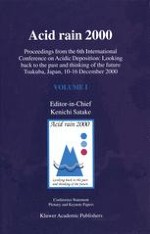2001 | OriginalPaper | Buchkapitel
Air Pollution Effects on Terrestrial Ecosystems in Estonia
verfasst von : Leo Saare, Reet Talkop, Ott Roots
Erschienen in: Acid rain 2000
Verlag: Springer Netherlands
Enthalten in: Professional Book Archive
Aktivieren Sie unsere intelligente Suche, um passende Fachinhalte oder Patente zu finden.
Wählen Sie Textabschnitte aus um mit Künstlicher Intelligenz passenden Patente zu finden. powered by
Markieren Sie Textabschnitte, um KI-gestützt weitere passende Inhalte zu finden. powered by
A number of positive changes have taken place since Estonia regained its independence in 1991. Air pollution from stationary sources has decreased over 2.5 times during 1990-1999, emissions of solid particles and SO2 have declined 74% and 60%, respectively. The content of heavy metals in Estonian mosses has decreased in comparison with the early 1990s. Last five years occurrence of different kind of damages on decidious trees has not been frequent.Those facts indicate that air pollution with heavy metals and other pollutants has diminished during the last few years. As the pH of precipitation fluctuates in different parts of Estonia, it is very important to study the effect of precipitation on ecosystems on the basis of critical loads. Results indicate that, as for eutrophicating nitrogen, the actual nitrogen deposition in North-East Estonia and West-Estonian islands roughly coincides with the limits for pollution endurance. This pattern also applies to the total deposition of sulphur and nitrogen in South, North and North-East Estonia, although in some Northern and North-Eastern areas pollution endurance limits have been exceeded.
